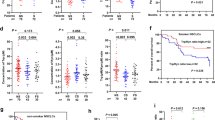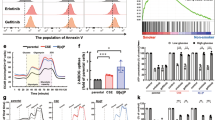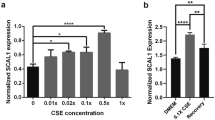Abstract
The role of thromboxane A2 (TxA2) in smoking-associated lung cancer is poorly understood. This study was conducted to study the role of TxA2 in smoking carcinogen 4-(methylnitrosamino)-1-(3-pyridyl)-1-butanone (NNK)-promoted cell survival and growth in human lung cancer cells. We found that NNK increased TxA2 synthase (TxAS) expression and thromboxane B2 (TxB2) generation in cultured lung cancer cells, the result of which was supported by the increased level of TxAS in lung cancer tissues of smokers. Both TxAS-specific inhibitor furegrelate and TxA2 receptor antagonist SQ29548 completely blocked NNK-mediated cell survival and growth via inducting apoptosis. TxA2 receptor agonist U46619 reconstituted a near-full survival and growth response to NNK when TxAS was inhibited, affirming the role of TxA2 receptor in NNK-mediated cell survival and growth. Suppression of cyclic adenosine monophosphate response element binding protein (CREB) activity by its small interference RNA blocked the effect of NNK. Phosphatidylinositol 3-kinase (PI3K)/Akt and extracellular signal-regulated kinase (ERK) also had a positive role. Altogether, our results have revealed that NNK stimulates TxA2 synthesis and activates its receptor in lung cancer cells. The increased TxA2 may then activate CREB through PI3K/Akt and extracellular ERK pathways, thereby contributing to the NNK-promoted survival and growth of lung cancer cells.
This is a preview of subscription content, access via your institution
Access options
Subscribe to this journal
Receive 50 print issues and online access
$259.00 per year
only $5.18 per issue
Buy this article
- Purchase on Springer Link
- Instant access to full article PDF
Prices may be subject to local taxes which are calculated during checkout







Similar content being viewed by others
References
Aggarwal S, Kim SW, Ryu SH, Chung WC, Koo JS . (2008). Growth suppression of lung cancer cells by targeting cyclic AMP response element-binding protein. Cancer Res 68: 981–988.
Amin S, Desai D, Hecht SS, Hoffmann D . (1996). Synthesis of tobacco-specific N-nitrosamines and their metabolites and results of related bioassays. Crit Rev Toxicol 26: 139–147.
Aronov AM, Baker C, Bemis GW, Cao J, Chen G, Ford PJ et al. (2007). Flipped out: structure-guided design of selective pyrazolylpyrrole ERK inhibitors. J Med Chem 50: 1280–1287.
Cailleteau C, Liagre B, Battu S, Jayat-Vignoles C, Beneytout JL . (2008). Increased cyclooxygenase-2 and thromboxane synthase expression is implicated in diosgenin-induced megakaryocytic differentiation in human erythroleukemia cells. Anal Biochem 380: 26–34.
Calapai G, Caputi AP, Mannucci C, Gregg EO, Pieratti A, Aurora Russo G et al. (2009). A cross-sectional investigation of biomarkers of risk after a decade of smoking. Inhal Toxicol 21: 1138–1143.
Cathcart MC, Reynolds JV, O′Byrne KJ, Pidgeon GP . (2010). The role of prostacyclin synthase and thromboxane synthase signaling in the development and progression of cancer. Biochim Biophys Acta 1805: 153–166.
Chen GG, Lee TW, Yip JH, Xu H, Lee IK, Mok TS et al. (2006). Increased thromboxane B(2) levels are associated with lipid peroxidation and Bcl-2 expression in human lung carcinoma. Cancer Lett 234: 193–198.
Ciani E, Guidi S, Bartesaghi R, Contestabile A . (2002). Nitric oxide regulates cGMP-dependent cAMP-responsive element binding protein phosphorylation and Bcl-2 expression in cerebellar neurons: implication for a survival role of nitric oxide. J Neurochem 82: 1282–1289.
Coleman RA, Humphrey PP, Kennedy I, Levy GP, Lumley P . (1981). Comparison of the actions of U-46619, a prostaglandin H2-analogue, with those of prostaglandin H2 and thromboxane A2 on some isolated smooth muscle preparations. Br J Pharmacol 73: 773–778.
Daniel TO, Liu H, Morrow JD, Crews BC, Marnett LJ . (1999). Thromboxane A2 is a mediator of cyclooxygenase-2-dependent endothelial migration and angiogenesis. Cancer Res 59: 4574–4577.
de Leval X, Dassesse T, Dogné JM, Waltregny D, Bellahcène A, Benoit V et al. (2006). Evaluation of original dual thromboxane A2 modulators as antiangiogenic agents. J Pharmacol Exp Ther 318: 1057–1067.
El-Bayoumy K, Iatropoulos M, Amin S, Hoffmann D, Wynder EL . (1999). Increased expression of cyclooxygenase-2 in rat lung tumors induced by the tobacco-specific nitrosamine 4-(methylnitrosamino)-4-(3-pyridyl)-1-butanone: the impact of a high-fat diet. Cancer Res 59: 1400–1403.
Ermert L, Dierkes C, Ermert M . (2003). Immunohistochemical expression of cyclooxygenase isoenzymes and downstream enzymes in human lung tumors. Clin Cancer Res 9: 1577–1578.
Fahn HJ, Wang LS, Kao SH, Chang SC, Huang MH, Wei YH . (1998). Smoking-associated mitochondrial DNA mutations and lipid peroxidation in human lung tissues. Am J Respir Cell Mol Biol 19: 901–909.
Grozio A, Catassi A, Cavalieri Z, Paleari L, Cesario A, Russo P . (2007). Nicotine, lung and cancer. Anticancer Agents Med Chem 7: 461–466.
Hecht SS . (2002). Cigarette smoking and lung cancer: chemical mechanisms and approaches to prevention. Lancet Oncol 3: 461–469.
Hoffmann D, Brunnemann KD, Prokopczyk B, Djordjevic MV . (1994). Tobacco-specific N-nitrosamines and Areca-derived N-nitrosamines: chemistry, biochemistry, carcinogenicity, and relevance to humans. J Toxicol Environ Health 41: 1–52.
Huang JS, Ramamurthy SK, Lin X, Le Breton GC . (2004). Cell signalling through thromboxane A2 receptors. Cell Signal 16: 521–533.
Hung YH, Hung WC . (2009). 4-(Methylnitrosamino)-1-(3-pyridyl)-1-butanone (NNK) enhances invasiveness of lung cancer cells by up-regulating contactin-1 via the alpha7 nicotinic acetylcholine receptor/ERK signaling pathway. Chem Biol Interact 179: 154–159.
Kelley DJ, Mestre JR, Subbaramaiah K, Sacks PG, Schantz SP, Tanabe T et al. (1997). Benzo[a]pyrene up-regulates cyclooxygenase-2 gene expression in oral epithelial cells. Carcinogenesis 18: 795–799.
Kim Y, Chongviriyaphan N, Liu C, Russell RM, Wang XD . (2006). Combined antioxidant (beta-carotene, alpha-tocopherol and ascorbic acid) supplementation increases the levels of lung retinoic acid and inhibits the activation of mitogen-activated protein kinase in the ferret lung cancer model. Carcinogenesis 27: 1410–1419.
Laag E, Majidi M, Cekanova M, Masi T, Takahashi T, Schuller HM . (2006). NNK activates ERK1/2 and CREB/ATF-1 via β-1-AR and EGFR signaling in human lung adenocarcinoma and small airway epithelial cells. Int J Cancer 119: 1547–1552.
Leung KC, Hsin MK, Chan JS, Yip JH, Li M, Leung BC et al. (2009). Inhibition of thromboxane synthase induces lung cancer cell death via increasing the nuclear p27. Exp Cell Res 315: 2974–2981.
Li MY, Hsin MK, Yip J, Mok TS, Underwood MJ, Chen GG . (2010). PPAR{gamma} activation extinguishes smoking carcinogen by inhibiting NNK-mediated proliferation. Am J Respir Cell Mol Biol 42: 113–122.
Li MY, Yip J, Hsin MK, Mok TS, Wu Y, Underwood MJ et al. (2008). Haem oxygenase-1 plays a central role in NNK-mediated lung carcinogenesis. Eur Respir J 32: 911–923.
Li X, Tai HH . (2009). Activation of thromboxane A (2) receptors induces orphan nuclear receptor Nurr1 expression and stimulates cell proliferation in human lung cancer cells. Carcinogenesis 30: 1606–1613.
Li X, Wei J, Tai HH . (2007). Activation of extracellular signal-regulated kinase by 12-hydroxy- heptadecatrienoic acid in prostate cancer PC3 cells. Arch Biochem Biophys 467: 20–30.
Lu G, Liao J, Yang G, Reuhl KR, Hao X, Yang CS . (2006). Inhibition of adenoma progression to adenocarcinoma in a 4-(methylnitrosamino)-1-(3-pyridyl)-1-butanone-induced lung tumorigenesis model in A/J mice by tea polyphenols and caffeine. Cancer Res 66: 11494–11501.
Ma PC, Tretiakova MS, Nallasura V, Jagadeeswaran R, Husain AN, Salgia R . (2007). Downstream signalling and specific inhibition of c-MET/HGF pathway in small cell lung cancer: implications for tumour invasion. Br J Cancer 97: 368–377.
McLemore TL, Hubbard WC, Litterst CL, Liu MC, Miller S, McMahon NA et al. (1988). Profiles of prostaglandin biosynthesis in normal lung and tumor tissue from lung cancer patients. Cancer Res 48: 3140–3147.
Merighi S, Benini A, Mirandola P, Gessi S, Varani K, Leung E et al. (2006). Modulation of the Akt/Ras/Raf/MEK/ERK pathway by A(3) adenosine receptor. Purinergic Signal 2: 627–632.
Miggin SM, Kinsella BT . (2001). Thromboxane A (2) receptor mediated activation of the mitogen activated protein kinase cascades in human uterine smooth muscle cells. Biochim Biophys Acta 1539: 147–162.
Mosmann T . (1983). Rapid colorimetric assay for cellular growth and survival: application to proliferation and cytotoxicity assays. J Immunol Methods 65: 55–63.
Moussa O, Ashton AW, Fraig M, Garrett-Mayer E, Ghoneim MA, Halushka PV et al. (2008b). Novel role of thromboxane receptors beta isoform in bladder cancer pathogenesis. Cancer Res 68: 4097–4104.
Moussa O, Riker JM, Klein J, Fraig M, Halushka PV, Watson DK . (2008a). Inhibition of thromboxane synthase activity modulates bladder cancer cell responses to chemotherapeutic agents. Oncogene 27: 55–62.
Nakahata N . (2008). Thromboxane A2: physiology/pathophysiology, cellular signal transduction and pharmacology. Pharmacol Ther 118: 18–35.
Nie D, Che M, Zacharek A, Qiao Y, Li L, Li X et al. (2004). Differential expression of thromboxane synthase in prostate carcinoma: role in tumor cell motility. Am J Pathol 164: 429–439.
Nie D, Lamberti M, Zacharek A, Li L, Szekeres K, Tang K et al. (2000). Thromboxane A(2) regulation of endothelial cell migration, angiogenesis, and tumor metastasis. Biochem Biophys Res Commun 267: 245–251.
Nishioka T, Guo J, Yamamoto D, Chen L, Huppi P, Chen CY . (2010). Nicotine, through upregulating pro-survival signaling, cooperates with NNK to promote transformation. J Cell Biochem 109: 152–161.
Parsons A, Daley A, Begh R, Aveyard P . (2010). Influence of smoking cessation after diagnosis of early stage lung cancer on prognosis: systematic review of observational studies with meta-analysis. Br Med J 340: b5569.
Proulx LI, Gaudreault M, Turmel V, Augusto LA, Castonguay A, Bissonnette EY . (2005). 4-(Methylnitrosamino)-1-(3-pyridyl)-1-butanone, a component of tobacco smoke, modulates mediator release from human bronchial and alveolar epithelial cells. Clin Exp Immunol 140: 46–53.
Sakai H, Suzuki T, Takahashi Y, Ukai M, Tauchi K, Fujii T et al. (2006). Upregulation of thromboxane synthase in human colorectal carcinoma and the cancer cell proliferation by thromboxane A2. FEBS Lett 580: 3368–3374.
Sakamoto KM, Frank DA . (2009). CREB in the pathophysiology of cancer: implications for targeting transcription factors for cancer therapy. Clin Cancer Res 15: 2583–2587.
Sebolt-Leopold JS, Herrera R . (2004). Targeting the mitogen-activated protein kinase cascade to treat cancer. Nat Rev Cancer 4: 937–947.
Stoimenov I, Helleday T . (2009). PCNA on the crossroad of cancer. Biochem Soc Trans 37: 605–613.
Wei J, Yan W, Li X, Chang WC, Tai HH . (2007). Activation of thromboxane receptor alpha induces expression of cyclooxygenase-2 through multiple signaling pathways in A549 human lung adenocarcinoma cells. Biochem Pharmacol 74: 787–800.
West KA, Brognard J, Clark AS, Linnoila IR, Yang X, Swain SM et al. (2003). Rapid Akt activation by nicotine and a tobacco carcinogen modulates the phenotype of normal human airway epithelial cells. J Clin Invest 111: 81–90.
Acknowledgements
We thank Suk Ying Chun, Ernest Chi Wai Chak and Billy Cheuk Sing Leung for their technical assistance. This study was supported by the CUHK direct grants (2007.2.045 and 2008.2.038).
Author information
Authors and Affiliations
Corresponding author
Ethics declarations
Competing interests
The authors declare no conflict of interest.
Rights and permissions
About this article
Cite this article
Huang, RY., Li, MY., Hsin, M. et al. 4-Methylnitrosamino-1-3-pyridyl-1-butanone (NNK) promotes lung cancer cell survival by stimulating thromboxane A2 and its receptor. Oncogene 30, 106–116 (2011). https://doi.org/10.1038/onc.2010.390
Received:
Revised:
Accepted:
Published:
Issue Date:
DOI: https://doi.org/10.1038/onc.2010.390
Keywords
This article is cited by
-
Human tumor necrosis factor alpha-induced protein eight-like 1 exhibited potent anti-tumor effect through modulation of proliferation, survival, migration and invasion of lung cancer cells
Molecular and Cellular Biochemistry (2021)
-
Targeting lipid mediators in cancer biology
Cancer and Metastasis Reviews (2018)
-
SUMOylation and SENP3 regulate STAT3 activation in head and neck cancer
Oncogene (2016)
-
Single-molecule force spectroscopy study of the effect of cigarette carcinogens on thrombomodulin–thrombin interaction
Science Bulletin (2016)
-
Differential involvement of gp130 signalling pathways in modulating tobacco carcinogen-induced lung tumourigenesis
Oncogene (2015)



